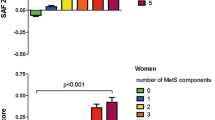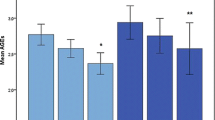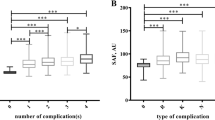Abstract
Background
As a clinical and non-invasive tool, the AGE Reader measures skin autofluorescence (SAF) to estimate the accumulation of advanced glycation end products (AGEs) in the skin. Accumulation of AGEs has been implicated in several inflammation-associated diseases, including diabetes and cardio-metabolic diseases. This study aimed to assess SAF in subjects with and without cardiovascular risk (CVR) factors and examine the association between SAF and various bio-clinical parameters.
Methods
In a cross-sectional study, we included 250 participants between 19 and 86 years of age divided into two groups: a healthy group (n = 88) and subjects with CVR factors (n = 162 in total, diabetes n = 48, hypertension n = 62, and both n = 52). We assessed skin AGE measures and biological and clinical data.
Results
SAF was significantly higher in subjects with CVR factors than in healthy participants (2.42 ± 0.38 vs 1.90 ± 0.29 respectively; p < 0.001). SAF was associated with age, gender, BMI, duration of diabetes, HbA1c, triglyceride, and obesity. Multivariate analysis showed that age and duration of diabetes were the independent determinants of SAF. The ROC analysis indicated that a SAF > 2.25 AU was the optimal cut-off point to predict the presence of diabetes and/or hypertension and dyslipidemia (p < 0.001).
Conclusion
This Tunisian population-based study shows an increased SAF level in subjects with diabetes and/or hypertension and dyslipidemia compared to healthy subjects. The AGE Reader device is a rapid and non-invasive tool in clinical practice to evaluate and screen CVR factors in Tunisia with a North African phototype.


Similar content being viewed by others
Availability of data and materials
The datasets used and/or analyzed during the current study are available from the corresponding author on reasonable request.
Abbreviations
- AGEs:
-
advanced glycation end products
- BMI:
-
body mass index
- CVR:
-
cardiovascular risk
- DBP:
-
diastolic blood pressure
- DM:
-
diabetes mellitus
- HbA1c:
-
glycated hemoglobin
- HTA:
-
hypertension
- SAF:
-
skin autofluorescence
- SBP:
-
systolic blood pressure
References
Ben Romdhane H, Ben Ali S, Aissi W, Traissac P, Aounallah-Skhiri H, Bougatef S, et al. Prevalence of diabetes in Northern African countries: the case of Tunisia. BMC Public Health. 2014;14:86.
Maoui A, Bouzid K, Ben Abdelaziz A, Ben abdelaziz A. Epidemiology of type 2 diabetes in the greater Maghreb. Example of Tunisia. Systematic review of the literature. La Tunisie Medicale. 2019;97:286–95.
Romdhane HB, Ali SB, Skhiri H, Traissac P, Bougatef S, Maire B, et al. Hypertension among Tunisian adults: results of the TAHINA project. Hypertens Res. 2012;35:341–7.
Kechida M. Cardio-metabolic risk factors in Tunisia: state of the art. Intern Emerg Med. 2020;15:537–42.
Dal Canto E, Ceriello A, Rydén L, Ferrini M, Hansen TB, Schnell O, Standl E, Beulens JW. Diabetes as a cardiovascular risk factor: an overview of global trends of macro and micro vascular complications. Eur J Prev Cardiol. 2019;26:25–32.
Brownlee M. Lilly lecture 1993. Glycation and diabetes complications. Diabetes. 1994;43:836–41.
Baynes JW, Thorpe SR. Glycoxidation and lipoxidation in atherogenesis. Free Radic Biol Med. 2000;28:1708–16.
Van Waateringe RP, Fokkens B, Slagter SN, van der Klauw MM, van Vliet-Ostaptchouk JV, et al. Skin autofluorescence predicts incident type 2 diabetes, cardiovascular disease and mortality in general population. Diabetologia. 2019;62:269–80.
Van Waateringe RP, Slagter SN, van Beek AP, van der Klauw MM, van Vliet-Ostaptchouk JV, Graaff R, et al. Skin autofluorescence, a non-invasive biomarker for advanced glycation end products, is associated with the metabolic syndrome and its individual components. Diabetol Metab Syndr. 2017;9:42.
Huebschmann AG, Regensteiner JG, Vlassara H, Reusch JE. Diabetes and advanced glycoxidation end products. Diabetes Care. 2006;29:1420–32.
Busch M, Franke S, Rüster C, Wolf G. Advanced glycation end-products and the kidney. Eur J Clin Invest. 2010;40:742–55.
de Vos LC, Mulder DJ, Smit AJ, Dullaart RP, Kleefstra N, Lijfering WM, Kamphuisen PW, Zeebregts CJ, Lefrandt JD. Skin autofluorescence is associated with 5-year mortality and cardiovascular events in patients with peripheral artery disease. Arterioscler Thromb Vasc Biol. 2014;34:933–8.
Kouidrat Y, Zaitouni A, Amad A, Diouf M, Desailloud R, Loas G, Lalau JD. Skin autofluorescence (a marker for advanced glycation end products) and erectile dysfunction in diabetes. J Diabetes Complications. 2017;31:108–13.
Schmitt A, Schmitt J, Mȕnch G, Gasic-Milencovic J. Characterization of advanced glycation end products for biochemical studies: side chain modifications and fluorescence characteristics. Anal Biochem. 2005;338:201–15.
Weiss MF, Erhard P, Kader-Attia FA, Wu YC, Deoreo PB, Araki A, Glomb MA, Monnier VM. Mechanisms for the formation of glycoxidation products in end-stage renal disease. Kidney Int. 2000;57:2571–85.
Kerkeni M, Saïdi A, Bouzidi H, Ben Yahya S, Hammami M. Elevated serum levels of AGEs, sRAGE, and pentosidine in Tunisian patients with severity of diabetic retinopathy. Microvasc Res. 2012;84:378–83.
Kerkeni M, Saïdi A, Bouzidi H, Ben Yahya S, Hammami M. Pentosidine as a biomarker for microvascular complications in type 2 diabetic patients. Diab Vasc Dis Res. 2013;10:239–45.
Kerkeni M, Weiss IS, Jaisson S, Dandana A, Addad F, Gillery P, Hammami M. Increased serum concentrations of pentosidine are related to presence and severity of coronary artery disease. Thromb Res. 2014;134:633–8.
Fokkens BT, Smit AJ. Skin fluorescence as a clinical tool for non-invasive assessment of advanced glycation and long-term complications of diabetes. Glycoconj J. 2016;33:527–35.
Fokkens BT, van Waateringe RP, Mulder DJ, Wolffenbuttel BHR, Smit AJ. Skin autofluorescence improves the Finnish Diabetes Score in the detection of diabetes in a large population based cohort: The LifeLines Cohort Study. Diabetes Metab. 2018;44:424–30.
Boersma HE, van Waateringe RP, van der Klauw MM, Graaff R, Paterson AD, Smit AJ, Wolffenbuttel BHR. Skin autofluorescence predicts new cardiovascular disease and mortality in people with type 2 diabetes. BMC Endocr Disord. 2021;21(1):14.
Koetsier M, Lutgers HL, de Jonge C, Links TP, Smit AJ, Graaff R. Reference values of skin autofluorescence. Diabetes Technol Ther. 2010;12:399–403.
Mook-Kanamori MJ, El-Din Selim MM, Takiddin AH, AI-Homsi H, AI-Mahmoud KAS, AI-Obaidli A, et al. Ethnic and gender differences in advanced glycation end products measured by skin auto-fluorescence. Dermato-Endocrinology. 2013;5:325–30.
Ahmad MS, Kimhofer T, Ahmad S, AIAma MN, Mosli HH, Hindawi SI, Mook-Kanamori DO, et al. Ethnicity and skin autofluorescence based risk engines for cardiovascular disease and diabetes mellitus. PLoS ONE. 2017;12(9):e0185175.
Van Waateringe RP, Mook-Kanamori MJ, Slagter SN, van der Klauw MM, van Vliet-Ostaptchouk JV, Graaff R, et al. The association between various smoking behaviors, cotinine biomarkers and skin autofluorescence. PLoS ONE. 2017;12(6):e0179330.
Botros N, Sluik D, van Waateringe RP, de Vries JH, Geelen A, Feskens EJ. Advanced glycation end products (AGEs) and associations with cardio-metabolic, lifestyle and dietary factors in a general population: the NQplus study. Diabetes Metab Res Rev. 2017;17:259.
Brownlee M. Advanced protein glyocsylation in diabetes and aging. Annu Rev Med. 1995;46:223–34.
Chakraborty S, Mandal J, Yang T, Cheng X, Yeo JY, McCarthy CG, Wenceslau CF, Koch LG, Hill JW, Vijay-Kumar M, Joe B. Metabolites and hypertension: insights into hypertension as a metabolic disorder. Hypertension. 2020;75:1386–96.
Aronson D. Cross-linking of glycated collagen in the pathogenesis of arterial and myocardial stiffening of aging and diabetes. J Hypertens. 2003;21:3–12.
Noordzij MJ, Mulder DJ, Oomen PHN, Brouwer T, Jager J, Castro Cabezas M, Lefrandt JD, Smit AJ. Skin autofluorescence and risk of micro- and macrovascular complications in patients with diabetes mellitus a multi-center study. Diabt Med. 2012;29:1556–61.
Lutgers HL, Graaff R, Links TP, Ubink-Veltmaat LJ, Bilo HJ, Gans RO, et al. Skin autofluorescence as a non-invasive marker of vascular damage in patients with type 2 diabetes. Diabetes care. 2006;29:2654–9.
den Engelsen C, van den Donk M, Gorter KJ, Salomé PL, Rutten GE. Advanced glycation end products measured by skin autofluorescence in a population with central obesity. Dermato Endocrinol. 2012;4:33–8.
Noordzij MJ, Lefrandt JD, Graaff R, Smit AJ. Skin autofluorescence and glycemic variability. Diabetes Technol Ther. 2010;12:581–5.
Kellow NJ, Coughlan MT, Reid CM. Association between habitual dietary and lifestyle behaviours and skin autofluorescence (SAF), a marker of tissue accumulation of advanced glycation endproducts (AGEs), in healthy adults. Eur J Nutr. 2018;57:2209–16.
Acknowledgments
The authors would like to thank all the people who participated in this study
Author information
Authors and Affiliations
Contributions
MK, BHRW, SA, and SN conceived the idea and edited and finalized the manuscript. RS and MK performed the study design, skin autofluorescence measurement, data analysis, data interpretation, and writing. IK, WB, and HB helped in the recruitment of patients and clinical fulfillment. All authors read and approved the final manuscript.
Corresponding author
Ethics declarations
The study protocol follows the ethical guidelines of the declaration of Helsinki and has been approved by the ethics committees at the Hospital of Fattouma Bourguiba at Monastir-Tunisia. All participants signed the informed consent in writing before inclusion in the study.
Consent for publication
Not applicable
Competing interests
The authors declare no competing interests.
Additional information
Publisher’s note
Springer Nature remains neutral with regard to jurisdictional claims in published maps and institutional affiliations.
Rights and permissions
About this article
Cite this article
Sakly, R., Wolffenbuttel, B.H.R., Khochtali, I. et al. Increased skin autofluorescence of advanced glycation end products (AGEs) in subjects with cardiovascular risk factors. Int J Diabetes Dev Ctries 43, 613–620 (2023). https://doi.org/10.1007/s13410-022-01121-z
Received:
Accepted:
Published:
Issue Date:
DOI: https://doi.org/10.1007/s13410-022-01121-z




